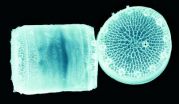(Press-News.org) Experimenting with cells in culture, researchers at the Johns Hopkins Kimmel Cancer Center have breathed possible new life into two drugs once considered too toxic for human cancer treatment. The drugs, azacitidine (AZA) and decitabine (DAC), are epigenetic-targeted drugs and work to correct cancer-causing alterations that modify DNA.
The researchers said the drugs also were found to take aim at a small but dangerous subpopulation of self-renewing cells, sometimes referred to as cancer stem cells, which evade most cancer drugs and cause recurrence and spread.
In a report published in the March 20, 2012, issue of Cancer Cell, the Johns Hopkins team said their study provides evidence that low doses of the drugs tested on cell cultures cause antitumor responses in breast, lung, and colon cancers.
Conventional chemotherapy agents work by indiscriminately poisoning and killing rapidly-dividing cells, including cancer cells, by damaging cellular machinery and DNA. "In contrast, low doses of AZA and DAC may re-activate genes that stop cancer growth without causing immediate cell-killing or DNA damage," says Stephen Baylin, M.D., Ludwig Professor of Oncology and deputy director of the Johns Hopkins Kimmel Cancer Center.
Many cancer experts had abandoned AZA and DAC for the treatment of common cancers, according to the researchers, because they are toxic to normal cells at standard high doses, and there was little research showing how they might work for cancer in general. Baylin and his colleague Cynthia Zahnow, Ph.D., decided to take another look at the drugs after low doses of the drugs showed a benefit in patients with a pre-leukemic disorder called myelodysplastic syndrome (MDS). Johns Hopkins investigators also showed benefit of low doses of the drugs in tests with a small number of advanced lung cancer patients. "This is contrary to the way we usually do things in cancer research," says Baylin, noting that "typically, we start in the laboratory and progress to clinical trials. In this case, we saw results in clinical trials that made us go back to the laboratory to figure out how to move the therapy forward."
For the research, Baylin and Zahnow's team worked with leukemia, breast, and other cancer cell lines and human tumor samples using the lowest possible doses that were effective against the cancers. In all, the investigators studied six leukemia cell lines, seven leukemia patient samples, three breast cancer cell lines, seven breast tumor samples (including four samples of tumors that had spread to the lung), one lung cancer tumor sample, and one colon cancer tumor sample. The team treated cell lines and tumor cells with low-dose AZA and DAC in culture for three days and allowed the drug-treated cells to rest for a week. Treated cells and tumor samples were then transplanted into mice where the researchers observed continued antitumor responses for up to 20 weeks. This extended response was in line with observations in some MDS patients who continued to have anticancer effects long after stopping the drug.
The low-dose therapy reversed cancer cell gene pathways, including those controlling cell cycle, cell repair, cell maturation, cell differentiation, immune cell interaction, and cell death. Effects varied among individual tumor cells, but the scientists generally saw that cancer cells reverted to a more normal state and eventually died. These results were caused, in part, by alteration of the epigenetic, or chemical environment, of DNA. Epigenetic activities turn on certain genes and block others, says Zahnow, assistant professor of oncology and the Evelyn Grolman Glick Scholar at Johns Hopkins.
The research team also tested AZA and DAC's effect on a type of metastatic breast cancer cell thought to drive cancer growth and resist standard therapies. Metastatic cells are difficult to study in standard laboratory tumor models, because they tend to break away from the original tumor and float around in blood and lymph fluids. The Johns Hopkins team re-created the metastatic stem cells' environment, allowing them to grow as floating spheres. "These cells were growing well as spheres in suspension, but when we treated the cells with AZA, both the size and number of spheres were dramatically reduced," says Zahnow.
The precise mechanism of how the drugs work is the focus of ongoing studies by Baylin and his team. "Our findings match evidence from recent clinical trials suggesting that the drugs shrink tumors more slowly over time as they repair altered mechanisms in cells and genes return to normal function and the cells may eventually die," says Baylin.
The results of clinical trials in lung cancer, led by Johns Hopkins' Charles Rudin, M.D., and published late last year in Cancer Discovery, also indicate that the drugs make tumors more responsive to standard anticancer drug treatment. This means, they say, that the drugs could become part of a combined treatment approach rather than a stand-alone therapy and as part of personalized approaches in patients whose cancers fit specific epigenetic and genetic profiles.
Low doses of both drugs are approved by the U.S. Food and Drug Administration for the treatment of MDS and chronic myelomonocytic leukemia (CMML). Clinical trials in breast and lung cancer have begun in patients with advanced disease, and trials in colon cancer are planned.
In addition to Baylin and Zahnow, other investigators participating in this study include Hsing-Chen Tsai, Huili Li, Leander Van Neste, Yi Cai, Carine Robert, Feyruz V. Rassool, James J. Shin, Kirsten M. Harbom, Robert Beaty, Emmanouil Pappou, James Harris, Ray-Whay Chiu Yen, Nita Ahuja, Malcolm V. Brock, Vered Stearns, David Feller-Kopman, Lonny B. Yarmus, Yi-Chun Lin, Alana L. Welm, Jean-Pierre Issa, Il Minn, William Matsui, Yoon-Young Jang, and Saul J. Sharkis.
The research was funded by a SPORE grant for lung cancer from the National Institutes of Health, the Hodson Trust Foundation, Entertainment Industry Foundation, Lee Jeans, Samuel Waxman Cancer Research Foundation, Department of Defense Breast Cancer Research Program, Huntsman Cancer Foundation, and the Cindy Rosencrans Fund for Triple Negative Breast Cancer Research. All of the studies have been accelerated by funding from the Stand Up to Cancer (SU2C) project in partnership with the American Association of Cancer Research (AACR).
On the Web:
Clinical trial of epigenetics therapy published in Cancer Discovery:
http://www.hopkinsmedicine.org/news/media/releases/combination_epigenetic_therapy_clinical_trial_results_
What is epigenetics?
http://www.hopkinsmedicine.org/kimmel_cancer_center/research_clinical_trials/research/su2c/what_is_epigenetics.html
SU2C Epigenetics Dream Team:
http://youtu.be/KgXBrxvlUeA
Stephen Baylin, M.D., explains epigenetics:
http://youtu.be/UW3f2XAxjdM
Scientists reprogram cancer cells with low doses of epigenetic drugs
2012-03-26
ELSE PRESS RELEASES FROM THIS DATE:
Eric Omand Attended AFL Mastermind This Past Weekend With Top Earning Online Entrepreneurs in New Jersey
2012-03-26
Top earning online entrepreneurs Aaron Rashkin and Sohia Rashkin as well as the Loyal 9 Revolution (Justin Woolf, Kevin Levonas, Anthony Busciglio, Jordon Crowder, Frank Scott, and Benny Bells) hosted the Legacy Mastermind this past weekend in Hasbrouck Heights, NJ. The Legacy Mastermind was all about taking action and the implementation of the nuts and bolts required to create a seven figure a year online business.
The same online leaders have hosted mastermind events in the past and all graduates report that their businesses have been catapulted as a result. 20 online ...
Pulp NonFiction: Fungal analysis reveals clues for targeted biomass deconstruction
2012-03-26
Without fungi and microbes to break down dead trees and leaf litter in nature, the forest floor might look like a scene from TV's "Hoarders."
Massive-scale genome sequencing projects supported by the U.S. Department of Energy (DOE) and being carried out at the DOE Joint Genome Institute (JGI) highlight the importance of learning how the cellulose, hemicellulose and lignin that serve as a plant's infrastructure can be broken down by these forest organisms to extract needed nutrients. Among the fungi being studied are species that can selectively break down the cell wall ...
Mayo Clinic-TGen study role testosterone may play in triple negative breast cancer
2012-03-26
SCOTTSDALE, Ariz. -- Could blocking a testosterone receptor lead to a new way to treat an aggressive form of breast cancer? That's a question researchers at Mayo Clinic in Arizona and the Translational Genomics Research Institute (TGen) are exploring. Preliminary results of a Mayo Clinic - TGen collaborative study shows the testosterone receptor may be a potential target to attack in treating triple negative breast cancer (TNBC).
Lead researcher Barbara Pockaj, M.D., a surgical oncologist at Mayo Clinic in Arizona will present the results of the study at the 65th annual ...
Magnetic field researchers target 100-tesla goal
2012-03-26
LOS ALAMOS, New Mexico, March 22, 2012 -- Researchers at Los Alamos National Laboratory's biggest magnet facility today met the grand challenge of producing magnetic fields in excess of 100 tesla while conducting six different experiments. The hundred-tesla level is roughly equivalent to 2 million times Earth's magnetic field.
"This is our moon shot, we've worked toward this for a decade and a half," said Chuck Mielke, director of the Pulsed Field Facility at Los Alamos.
The team used the 100-tesla pulsed, multi-shot magnet, a combination of seven coils sets weighing ...
Diatom biosensor could shine light on future nanomaterials
2012-03-26
SEQUIM, Wash. – A glow coming from the glassy shell of microscopic marine algae called diatoms could someday help us detect chemicals and other substances in water samples. And the fact that this diatom can glow in response to an external substance could also help researchers develop a variety of new, diatom-inspired nanomaterials that could solve problems in sensing, catalysis and environmental remediation.
Fluorescence is the key characteristic of a new biosensor developed by researchers at the Department of Energy's Pacific Northwest National Laboratory. The biosensor, ...
Ancient civilizations reveal ways to manage fisheries for sustainability
2012-03-26
In the search for sustainability of the ocean's fisheries, solutions can be found in a surprising place: the ancient past.
In a study published on March 23 in the journal Fish and Fisheries, a team of marine scientists reconstructed fisheries yields over seven centuries of human habitation in Hawaii and the Florida Keys, the largest coral reef ecosystems in the United States, and evaluated the management strategies associated with periods of sustainability. The results surprised them.
"Before European contact, Native Hawaiians were catching fish at rates that far ...
Adner Colon Attend Exclusive Action Freedom Legacy Mastermind Event at Hasbrouck Heights, NJ
2012-03-26
Online Marketing Entrepreneur Adner Colon knew his life would change when he joined Carbon Copy Pro in February 2012 but not in the way he expected.
Online Marketing Entrepreneur Adner Colon knew his life would change when he joined Carbon Copy Pro in February 2012 but not in the way he expected.
On March 24th and 25th Adner Colon will be attending an exclusive Action Freedom Legacy (AFL) Legacy Mastermind event at Hasbrouck Heights. The trainers for the event are Aaron and Sophia Raskin and members of the Loyal 9 who are top producers in the online marketing industry.
Here's ...
Low serum adiponectin levels predict future risk for asthma in women
2012-03-26
Low serum adiponectin levels predict an increased future risk for developing asthma in middle-aged women, particularly among smokers, according to a new study.
"Adiposity is known to be related to asthma. Although a causal link between adiponectin (a protein produced by adipose tissue) and asthma has been demonstrated in mice, the evidence in humans has been conflicting," said lead author Akshay Sood, MD, MPH, associate professor in the Division of Pulmonary and Critical Care Medicine at the University of New Mexico Health Sciences Center School of Medicine.
"In an ...
Periodontal therapy reduces hospitalizations and medical care costs in diabetics
2012-03-26
Tampa, Fla., USA – Today, during the 41st Annual Meeting & Exhibition of the American Association for Dental Research (AADR), held in conjunction with the 36th Annual Meeting of the Canadian Association for Dental Research, an abstract titled "Periodontal Therapy Reduces Hospitalizations and Medical Care Costs in Diabetics" to determine if periodontal treatment was associated with the number of hospitalizations and cost of medical care among diabetics with periodontal disease.
A longitudinal study compared medical costs for diabetic subjects with periodontal disease ...
Study: Preoperative estrogen-blocking therapy may preempt need for mastectomy
2012-03-26
Orlando – March 23, 2012. Preoperative treatment with aromatase inhibitors increases the likelihood that postmenopausal women with estrogen receptor-positive breast cancer will be able to have breast-conserving surgery rather than a mastectomy, according to the results of a national clinical trial presented today at the Society of Surgical Oncology annual meeting in Orlando, Fla.
"We found that half of the postmenopausal women in the study who initially faced having a mastectomy were able to have breast-conserving surgery after being treated for four months with an aromatase ...



